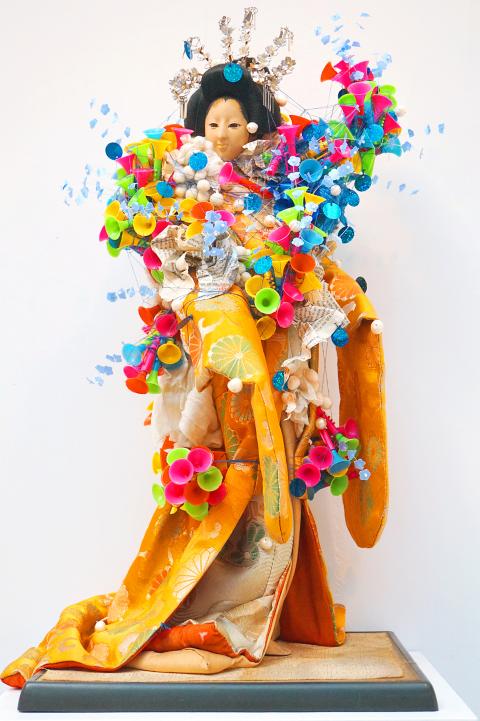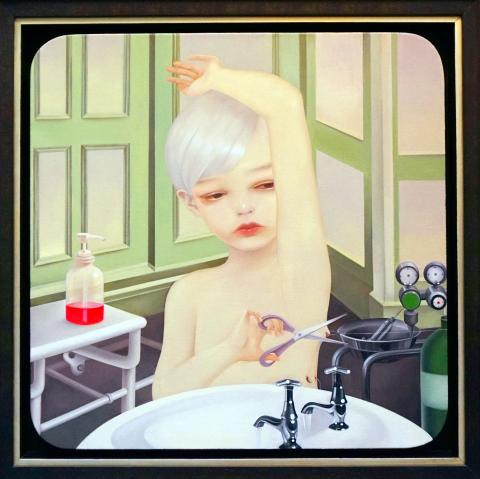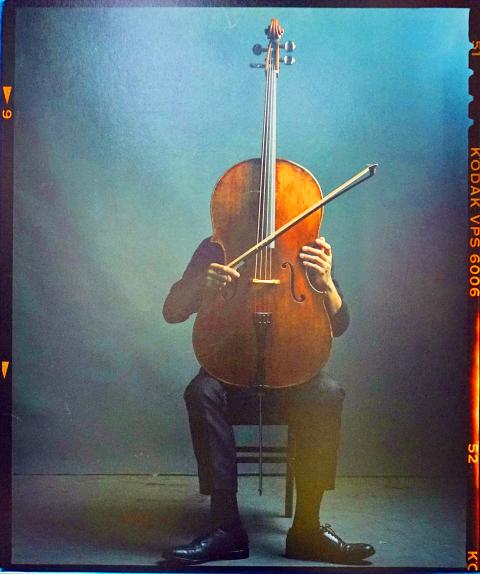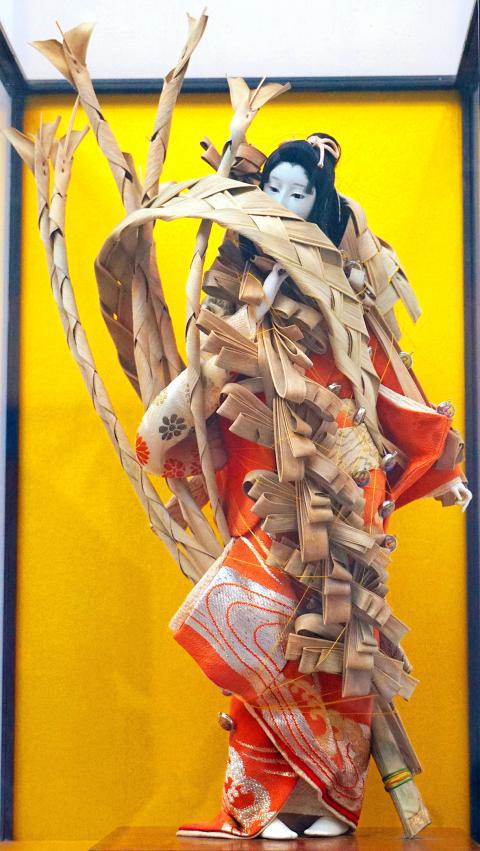The 21st annual Art Taipei kicked off on Friday with an eclectic concoction of colors, cultures and characters. The four-day art fair extravaganza which is currently taking place at the Taipei World Trade Center (台北世界貿易中心展覽) certainly lived up to its promise of not just appealing to high-rolling buyers, but also to ensuring that the experience of gallery-viewing was a more relatable and enjoyable one for the general public. Artists mingled with art enthusiasts, a variety of languages were spoken and the atmosphere was, largely speaking, lively and devoid of pretentiousness.
There were the usual big names — for instance, Annie Leibovitz’s 1998 portraiture of Yo-yo Ma with a cello hiding his face — but young, up-and-coming artists from all over Asia really held their own ground at Art Taipei this year. Moreover, the collections on display were far from conservative — vibrant colors, flirty motifs and contemporary reinterpretations of historical issues were among the most prominent themes tying the fair together.
HISTORY LESSONS

Photo: Dana Ter
A sizeable portion of artists this year hailed from Southeast Asia. Australian-based Filipino artist Miguel Aquilizan — whose headgear made out of taxidermy animals attracted as much attention as his artwork did — was one of these young artists chosen to represent the region.
Despite his chaotic ensemble, Aquilizan was calm and collected as he explained to the Taipei Times the symbolism behind his carefully refashioned Japanese dolls dating back to World War II which he had collected from antique shops around the Philippines. He acknowledged the utter physical and cultural destruction which occurred in his country, but also expressed a need to move on by constantly reinventing new meaning out of past catastrophes.
“I gather objects, research into their past and then create new meaning out of them. When I found the dolls, they looked very melancholic, so I reworked them to make them appear more cheerful,” Aquilizan said.

Photo: Dana Ter
The result is a fusion of different cultures, which is an inevitable fixture of modern-day life due to historical processes like colonialism and migration. The vibrant colors, rattan weavings and thick feathers, all of which are sewn into the dolls, are distinctly Filipino while the kimonos are obviously Japanese. On a lighter note, the dolls’ impeccable fashion sense are a nod to Aquilizan’s interest in fashion design.
On the other side of the historical pendulum, artist Nobuaki Takekawa’s oil on canvas Cicada Eclosion and I, 1250 Years (2014), provides a critical view of Japanese history over the past centuries. The painting resembles a genealogical chart with generations of offspring sprouting from common ancestors. Earlier generations are cicadas and their descendants are farmers and horsemen, eventually evolving into modern people.
The cicada motif is important since cicadas are meant to symbolize reincarnation in Japanese culture. Nobuaki’s depiction of the Nazi German flag and the Rising Sun flag alongside recent protests against the Shinzo Abe government draws similarities between past and present, suggesting that history repeats itself.

Photo: Dana Ter
ANIMAL INSTINCT
Animal imagery was surprisingly abundant at this year’s fair. Malaysian artist Haffendi Anuar’s Liquid Serpents 4 (The Garden) (2014) was eye-popping in the sense that his vinyl-printed snakes seemed like they would jump out and bite you despite being encased in multiple layers of Plexiglas.
Anuar said that he had always been fascinated by cold-blooded invertebrates like slugs, squids and snakes because despite their seemingly repulsive nature, there’s a certain earthiness to them that he finds alluring.

Photo: Dana Ter
“As we modernize, we tend to stray away from nature,” Anuar said, “but nature finds a way to get back into your life. For instance, we wash our hands from soap made out of aloe vera and wear face masks made out of snail slime.”
Anuar added that snakes represent knowledge but are protective of it like in the Garden of Eden story. He was also drawn to the cyclical nature of their skin and how it symbolizes the humdrum repetitiveness in our own modern-day lives — something universally relatable. On the other hand, according to Anuar, the oil spills interwoven with the snakes’ bodies are representative of Malaysia’s dependency on its oil industry.
Meanwhile, Shenyang-born, Beijing-based Chinese artist Shi Mohan (史墨涵) taps into the theme of loss of innocence, but through human rather than animal subjects. The young artist is known for depicting her innermost thoughts and morbid fantasies. Subjects like a child’s cherubic face, which seems pretty at first glance, are sullied when viewers realize that the child is holding a bloodied skull or that its limbs are distorted or, in the case of Surgery (2014), that she is performing surgery on herself.
LIGHT-HEARTED BUT WITTY
Other pieces of artwork were more light-hearted but equally witty and imbued with criticisms and commentary on modern-day life.
Taiwanese artist Chang Li-ren’s (張立人) animated photo frame Classic Skin Flick Series 12 (2013) appears to be a pleasant portrayal of a 1930s Shanghai-style pin-up girl with a bob haircut which were used for cigarette ads during the time. However, the model in the photo frame starts moving and pealing off her clothes one by one until she is sitting completely nude.
Despite the viewers’ gasps and giggles, the process of undressing is not just a silly act, but could be representative of the shift in public perceptions in Taiwan and in other countries of sex being a taboo topic to being something that is more openly embraced and discussed.
Similarly, Nissem Ben Aderet’s depictions of human figures interlocked and stacked on top of each other, sometimes sharing the same limbs, are comical yet deeply reflective. Upon closer examination, the Israeli artist’s artwork, which is all done with a single stroke of a marker is evocative of the stress and fatigue arising from over-crowdedness in big cities.
One does not need to be an art critic or high-flying buyer to attend Art Taipei this year. A lot of the artwork draws upon universal themes and will naturally speak to any open-minded, culturally-aware young person familiar with life in a global city, circa 2014.
Art Taipei runs until tomorrow at the Taipei World Trade Center, Exhibition Hall 1 (台北世界貿易中心展覽大樓一館), 5, Xinyi Rd Sec 5, Taipei City (台北市信義路五段五號). The exhibition is open from 11am to 7pm today and 11am to 6pm tomorrow. Admission is NT$200 to NT$500. More information in English and Chinese can be found at art-taipei.com.

Taiwan Power Co (Taipower, 台電) and the New Taipei City Government in May last year agreed to allow the activation of a spent fuel storage facility for the Jinshan Nuclear Power Plant in Shihmen District (石門). The deal ended eleven years of legal wrangling. According to the Taipower announcement, the city government engaged in repeated delays, failing to approve water and soil conservation plans. Taipower said at the time that plans for another dry storage facility for the Guosheng Nuclear Power Plant in New Taipei City’s Wanli District (萬里) remained stuck in legal limbo. Later that year an agreement was reached

June 2 to June 8 Taiwan’s woodcutters believe that if they see even one speck of red in their cooked rice, no matter how small, an accident is going to happen. Peng Chin-tian (彭錦田) swears that this has proven to be true at every stop during his decades-long career in the logging industry. Along with mining, timber harvesting was once considered the most dangerous profession in Taiwan. Not only were mishaps common during all stages of processing, it was difficult to transport the injured to get medical treatment. Many died during the arduous journey. Peng recounts some of his accidents in

What does the Taiwan People’s Party (TPP) in the Huang Kuo-chang (黃國昌) era stand for? What sets it apart from their allies, the Chinese Nationalist Party (KMT)? With some shifts in tone and emphasis, the KMT’s stances have not changed significantly since the late 2000s and the era of former president Ma Ying-jeou (馬英九). The Democratic Progressive Party’s (DPP) current platform formed in the mid-2010s under the guidance of Tsai Ing-wen (蔡英文), and current President William Lai (賴清德) campaigned on continuity. Though their ideological stances may be a bit stale, they have the advantage of being broadly understood by the voters.

In a high-rise office building in Taipei’s government district, the primary agency for maintaining links to Thailand’s 108 Yunnan villages — which are home to a population of around 200,000 descendants of the Chinese Nationalist Party (KMT) armies stranded in Thailand following the Chinese Civil War — is the Overseas Community Affairs Council (OCAC). Established in China in 1926, the OCAC was born of a mandate to support Chinese education, culture and economic development in far flung Chinese diaspora communities, which, especially in southeast Asia, had underwritten the military insurgencies against the Qing Dynasty that led to the founding of